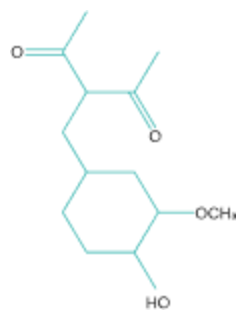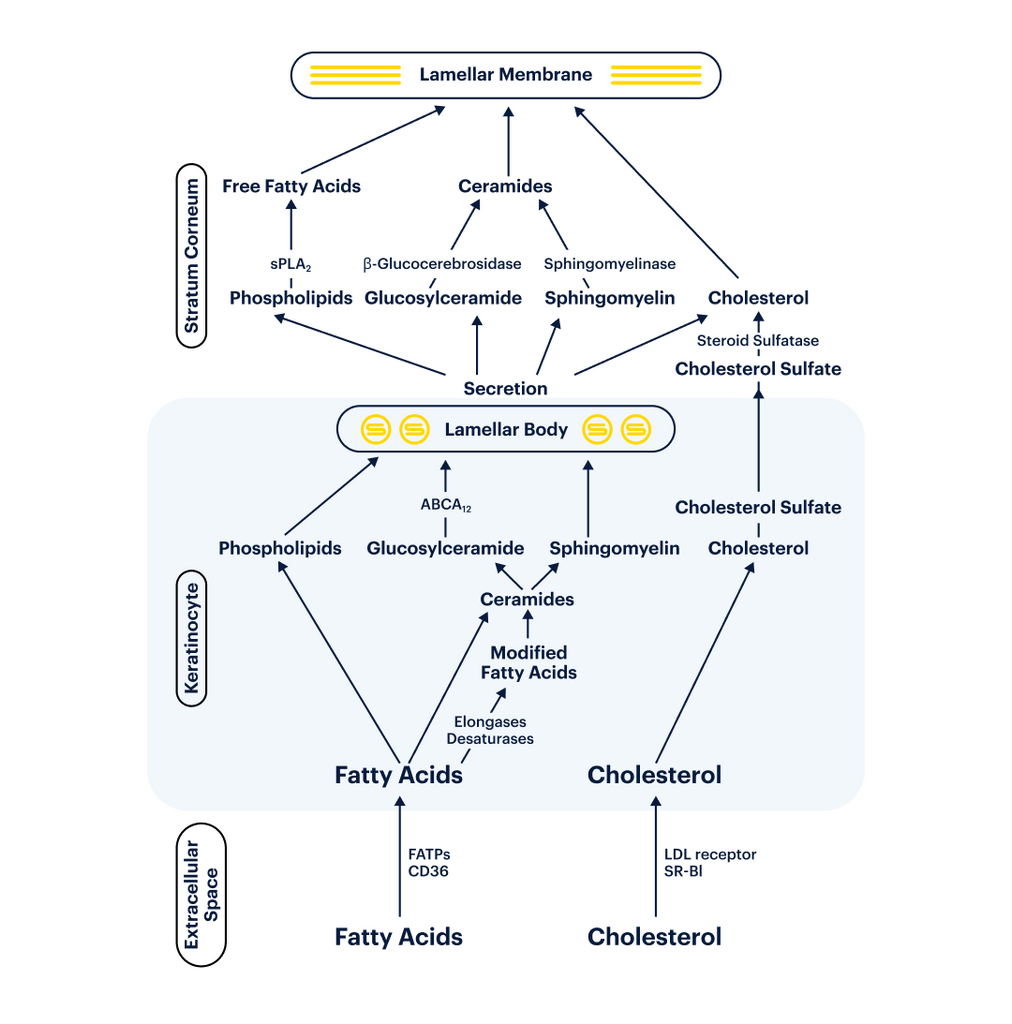MOLECULE

- Essential component of the barrier lipids
- Regulates inflammatory response
Regimen Lab Skincare Encyclopedia
Ceramides
*Preliminary Lab Notes* - Full Entry Under Development

TLDR
- Ceramide EOS is responsible for the proper structure of the lamellar layer
- Ceramide NP works synergistically with Ceramide 1 to form a proper structure
- Ceramides promote an Orthorhombic packing (Super tight semi-hexagonal arrangement)
- They also play a role in preventing an overexaggerated inflammatory response
Regimen's Take
Ceramides are the best ingredients you can use for barrier repair but they are complicated and fussy. Formulating them properly is a challenge and adding them to a formulation without Cholesterol and Fatty acids can delay barrier repair. They also need to be in a proper 3:1:1:1 ratio to get the maximum benefit from them. They need to fully penetrate to the Stratum Granulosum first, then be processed by the Lamellar Body Processing system. This means that they take a while to work, but they are a far superior method of Barrier Repair compared to Petrolatum alone. Although the science behind Ceramides is hot right now, we still need more comparisons against standard OTC products to unequivocally say they are better in terms of barrier repair.
Foreword: This is still a preliminary post, more of an introduction. The detailed one turned out to be a gigantic beast. We'll keep you posted once we post the detailed one. For now, enjoy our best effort in drawing the skin.
The Barrier Lipids
Ceramides are a group of lipids that comprise most of the barrier lipids present in your skin. They are sometimes called Intercellular lipids or Extracellular lipids as they are present in between cells. These lipids fill in the gap between your skin cells as they serve two main functions: 1. to keep moisture in and 2. to prevent the entry of foreign substances.

Think about the uppermost layer of the skin as a wall made out of bricks. The bricks represent the corneocytes (dead skin cells), while the cement in between the bricks is your barrier lipid layer. That is why you'll hear the term "cement lipids" referring to barrier lipids.
Your barrier lipids are composed of 50% Ceramides, 25% Cholesterol, 10-15% Fatty acids, and 5% other lipids. These lipids work in a specific arrangement to provide the ultimate protection of your skin while keeping it flexible and moisturized. They are arranged in a highly organized layer with each other.

As you can see in my cheese sandwich-looking drawing, the arrangement of the barrier lipids shows a long-short-long periodicity (this is important later). The polar heads arrange themselves in a lamellar layer, with their hydrophobic tails pointing inward, leading to this highly organized lamellar layer that prevents moisture loss or entry of pathogens. Each component has to be present (in a proper ratio) to form this highly organized structure.
What are Ceramides?
Ceramides are lipids that your skin produces to make itself semi-waterproof. When you talk about your skin's moisture barrier, Ceramides are the workhorse of barrier repair. They are composed of a sphingosine or sphingoid base (it does look like a sphinx hence the name) with an amide linkage to a fatty acid. The combination of these two components determines the ceramide type and function.

What are the different types of Ceramides?
Previously, Ceramides were named and numbered according to their relative polarity using HPTLC. As time went by, more ceramides were discovered, and the naming system became complicated as there were new ones with the polarity between Ceramide 5 and 6. Hence, the Personal Care council came up with a new naming system based on the system of Motta et. al.
There are four different types of Sphingoid bases with three types of Fatty acid groups. The four sphingoid bases vary in the presence of a double bond or a hydroxyl (-OH) group. At the same time, the Fatty acids vary on the position of the hydroxyl group (alpha denotes attachment to the first carbon, beta to second, so on and so forth). There are 12 possible combinations, but one of them hasn't been found in the skin yet.

Note: There are other types of Ceramides in the body, but we are only discussing the types found in the Stratum Corneum. Aside from the sphingoid base and hydroxyl position in the Fatty acids, ceramides can also vary in the degree of unsaturation and carbon-chain length of the fatty acid (will be discussed later).
How do Ceramides work?
Ceramides, together with Cholesterol and Fatty acids, are produced in the Stratum Granulosum. They are initially packed together in their glycosylated form (inactive) as lamellar bodies. These lamellar bodies are sac-like bags filled with folded barrier lipids and enzymes. They are extruded outside the SC-SG interface to merge with the existing barrier lipids after they get processed.

Think of your lamellar bodies as barrier bombs that explode to release a barricade. When an attack happens, your SG quickly releases all the pre-formed barrier bombs. This process is super quick; within 3 minutes, your SG would run out of these bombs. The good thing is that the deployed bombs released barricades on the streets for some protection. Luckily, these bombs come with robots that process the barricades into stronger, more resistant ones that are now connected. The cycle continues until your skin barrier returns to normal. Sounds cool, eh?
So what do these different types of Ceramides do?
As mentioned above, the ceramides work together to form a highly organized lamellar layer. There is still a lot to discover in their individual function, but recent research highlighted the importance of some notable ones:
Ceramide EOS (Previously Ceramide 1)
As the name suggests, Ceramide EOS is composed of a Sphingosine and an Ester-linked Omega-Hydroxy Fatty Acid. The fatty acid usually is Linoleic acid, but can also be Behenic, Lignoceric, Cerotic or Oleic acid. An increase in Cer EOS with Oleic acid is correlated with an impaired barrier. With the help of Ceramide NP, Ceramide EOS is responsible for maintaining the long-short-long periodicity (see above), which is an essential characteristic of a healthy skin barrier. Because of its length, it acts like a Velcro that allows the attachment of a newly processed lamellar layer. This feature coincides with several findings that TEWL is correlated with Ceramide EOS content. In fact, in some pathologic conditions such as Atopic Dermatitis, Ichthyosis, Sjogren-Larssen Syndrome and even with just dry and itchy skin, Cer EOS content is decreased.
Ceramide NP (Previously Ceramide 3)
Ceramide NP works together with Ceramide EOS in maintaining the proper structure of the lamellar layer. Think of Ceramide NP as the awesome sidekick that orients the newly processed lamellar lipids in order for Ceramide EOS to grab it like a Velcro. Like Cer EOS, it is significantly correlated with TEWL and barrier impairment.
Why do you need Ceramides?
You probably know by now the signs of barrier damage (redness, tightness, dryness, scaliness). However, these signs only appear when significant damage has already been done. Our skin encounters subclinical damage every day, but luckily, our skin has a solid way of repairing the skin through the release of Lamellar Bodies. Even though our skin can keep producing these barrier lipids, the level of Ceramide, Cholesterol and Fatty acids get depleted, especially in constant barrier damage. This event starts an exaggerated cascade of inflammatory events that lead to more damage to the skin.
Preventing or stopping this cycle of barrier damage is key to restoring barrier health. One way to interrupt this cycle is through the use of Steroids. As effective as they are, withdrawing them is a challenge as rebound inflammation can occur.
Recent studies have shown the potential of topical application of barrier lipids to damaged skin. Essentially, it helps stop the cycle of barrier damage by replenishing the supply of barrier lipids, allowing your SG to produce properly formed lamellar bodies. Several studies attest to their ability to expedite barrier repair, especially when properly formulated with occlusives, soothing agents, and low pH.
When do you not need ceramides?
There are some exceptional cases when the use of ceramides might not be appropriate. Unlike occlusives, barrier lipids need to be processed first by the SG and packaged into lamellar bodies for them to work. If this packaging system is impaired, as is in the case of newborns, burnt skin, irradiated skin (0-48 hours), they can't be processed by the skin. A more appropriate solution would be to occlude the skin with petrolatum until the skin regains its ability to process lipids.
Do they work?
(Meta-analysis is ongoing, but in essence, yes)
Are they the cure for atopic dermatitis? No. Are they the next big magical ingredient? No. Ceramides are not some new ingredient that would solve all your problems. They're already present in your skin, and you are just adding back what you've lost. Can they help with barrier repair? Absolutely. One caveat with these guys is that improper formulation may even delay barrier repair. (More on the investigation of the proper ratio soon)
Are all Ceramides created equal?
Yes, they are all created equal, but some are more equal than others. Just kidding. No, more is less. You don't need to apply many types of Ceramide to your skin. In fact, some types of Ceramide actually increase in damaged skin. The only ones showing a consistent decrease in levels are Ceramide EOS, NP, and EOH.
What to look out for?
Look out for a complete formulation with Cholesterol and Fatty acids. If you see the following ingredients in the INCI, the amount of Ceramides is just at 0.075-0.15%: Ceramide NP (and) Ceramide AP (and) Ceramide EOP (and) Phytosphingosine (and) Cholesterol (and) Sodium Lauroyl Lactylate (and) Carbomer (and) Xanthan Gum. Also, you won't find Ceramide EOS in any INCI as the nomenclature combined both Ceramide 1 and 9 into EOP.
Studies done on Ceramides mixed with Cholesterol and Fatty acids




Studies done on Ceramides without Cholesterol and Fatty acids



Studies done on Pseudoceramides




Studies done on Ceramide stimulation in the skin



